Ahmed Elgammal
DirectorLLM for Human-Centric Video Generation
Dec 19, 2024



Abstract:In this paper, we introduce DirectorLLM, a novel video generation model that employs a large language model (LLM) to orchestrate human poses within videos. As foundational text-to-video models rapidly evolve, the demand for high-quality human motion and interaction grows. To address this need and enhance the authenticity of human motions, we extend the LLM from a text generator to a video director and human motion simulator. Utilizing open-source resources from Llama 3, we train the DirectorLLM to generate detailed instructional signals, such as human poses, to guide video generation. This approach offloads the simulation of human motion from the video generator to the LLM, effectively creating informative outlines for human-centric scenes. These signals are used as conditions by the video renderer, facilitating more realistic and prompt-following video generation. As an independent LLM module, it can be applied to different video renderers, including UNet and DiT, with minimal effort. Experiments on automatic evaluation benchmarks and human evaluations show that our model outperforms existing ones in generating videos with higher human motion fidelity, improved prompt faithfulness, and enhanced rendered subject naturalness.
MoMA: Multimodal LLM Adapter for Fast Personalized Image Generation
Apr 08, 2024Abstract:In this paper, we present MoMA: an open-vocabulary, training-free personalized image model that boasts flexible zero-shot capabilities. As foundational text-to-image models rapidly evolve, the demand for robust image-to-image translation grows. Addressing this need, MoMA specializes in subject-driven personalized image generation. Utilizing an open-source, Multimodal Large Language Model (MLLM), we train MoMA to serve a dual role as both a feature extractor and a generator. This approach effectively synergizes reference image and text prompt information to produce valuable image features, facilitating an image diffusion model. To better leverage the generated features, we further introduce a novel self-attention shortcut method that efficiently transfers image features to an image diffusion model, improving the resemblance of the target object in generated images. Remarkably, as a tuning-free plug-and-play module, our model requires only a single reference image and outperforms existing methods in generating images with high detail fidelity, enhanced identity-preservation and prompt faithfulness. Our work is open-source, thereby providing universal access to these advancements.
AI Art Neural Constellation: Revealing the Collective and Contrastive State of AI-Generated and Human Art
Feb 04, 2024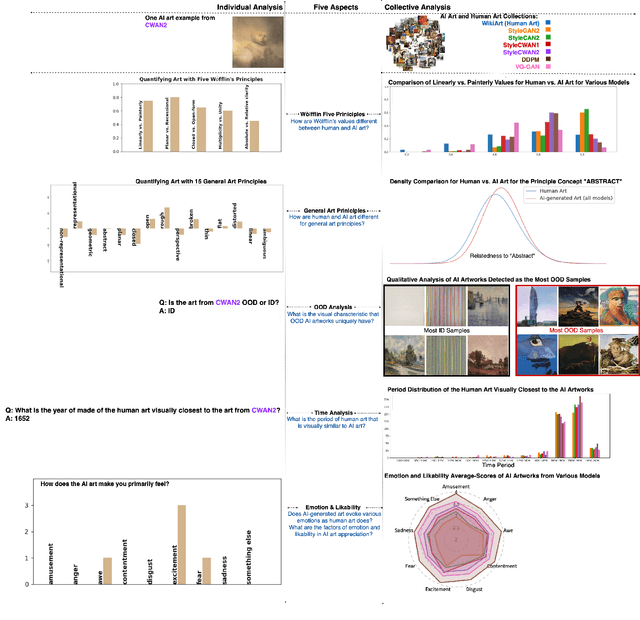
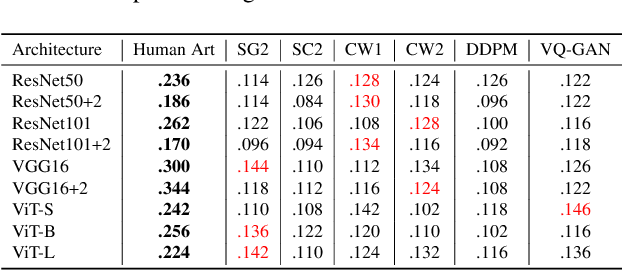


Abstract:Discovering the creative potentials of a random signal to various artistic expressions in aesthetic and conceptual richness is a ground for the recent success of generative machine learning as a way of art creation. To understand the new artistic medium better, we conduct a comprehensive analysis to position AI-generated art within the context of human art heritage. Our comparative analysis is based on an extensive dataset, dubbed ``ArtConstellation,'' consisting of annotations about art principles, likability, and emotions for 6,000 WikiArt and 3,200 AI-generated artworks. After training various state-of-the-art generative models, art samples are produced and compared with WikiArt data on the last hidden layer of a deep-CNN trained for style classification. We actively examined the various art principles to interpret the neural representations and used them to drive the comparative knowledge about human and AI-generated art. A key finding in the semantic analysis is that AI-generated artworks are visually related to the principle concepts for modern period art made in 1800-2000. In addition, through Out-Of-Distribution (OOD) and In-Distribution (ID) detection in CLIP space, we find that AI-generated artworks are ID to human art when they depict landscapes and geometric abstract figures, while detected as OOD when the machine art consists of deformed and twisted figures. We observe that machine-generated art is uniquely characterized by incomplete and reduced figuration. Lastly, we conducted a human survey about emotional experience. Color composition and familiar subjects are the key factors of likability and emotions in art appreciation. We propose our whole methodologies and collected dataset as our analytical framework to contrast human and AI-generated art, which we refer to as ``ArtNeuralConstellation''. Code is available at: https://github.com/faixan-khan/ArtNeuralConstellation
Diffusion Guided Domain Adaptation of Image Generators
Dec 09, 2022Abstract:Can a text-to-image diffusion model be used as a training objective for adapting a GAN generator to another domain? In this paper, we show that the classifier-free guidance can be leveraged as a critic and enable generators to distill knowledge from large-scale text-to-image diffusion models. Generators can be efficiently shifted into new domains indicated by text prompts without access to groundtruth samples from target domains. We demonstrate the effectiveness and controllability of our method through extensive experiments. Although not trained to minimize CLIP loss, our model achieves equally high CLIP scores and significantly lower FID than prior work on short prompts, and outperforms the baseline qualitatively and quantitatively on long and complicated prompts. To our best knowledge, the proposed method is the first attempt at incorporating large-scale pre-trained diffusion models and distillation sampling for text-driven image generator domain adaptation and gives a quality previously beyond possible. Moreover, we extend our work to 3D-aware style-based generators and DreamBooth guidance.
Formal Analysis of Art: Proxy Learning of Visual Concepts from Style Through Language Models
Jan 05, 2022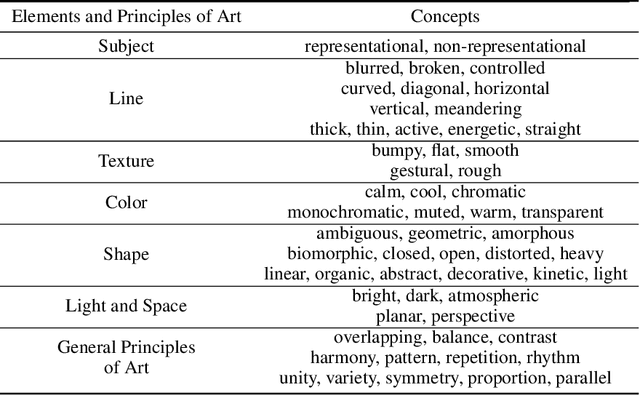
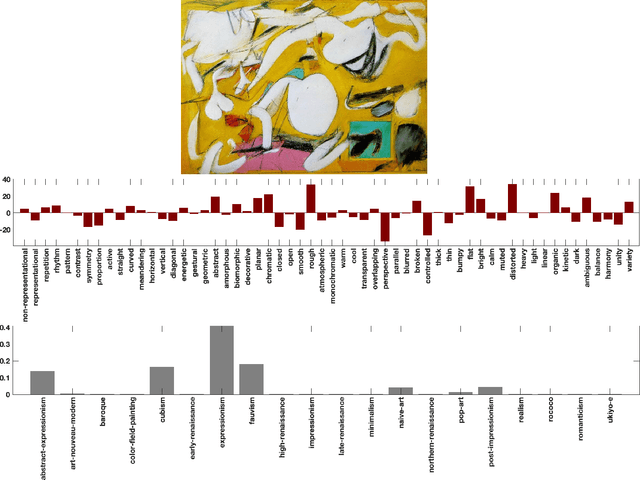
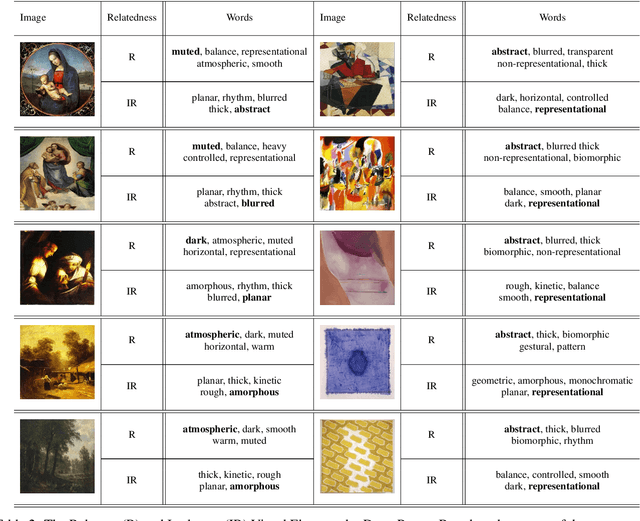
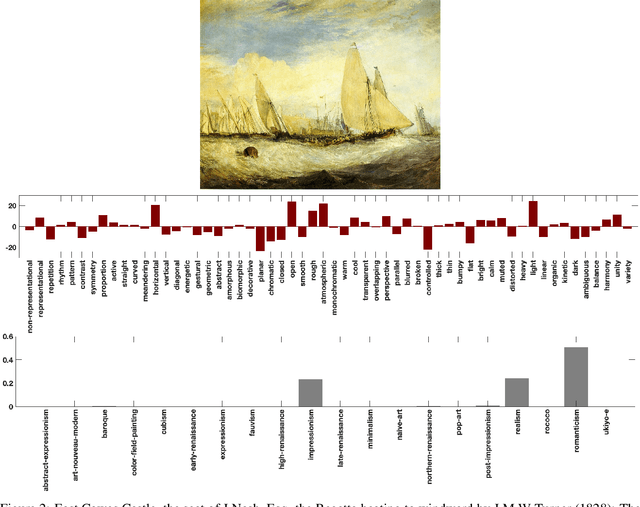
Abstract:We present a machine learning system that can quantify fine art paintings with a set of visual elements and principles of art. This formal analysis is fundamental for understanding art, but developing such a system is challenging. Paintings have high visual complexities, but it is also difficult to collect enough training data with direct labels. To resolve these practical limitations, we introduce a novel mechanism, called proxy learning, which learns visual concepts in paintings though their general relation to styles. This framework does not require any visual annotation, but only uses style labels and a general relationship between visual concepts and style. In this paper, we propose a novel proxy model and reformulate four pre-existing methods in the context of proxy learning. Through quantitative and qualitative comparison, we evaluate these methods and compare their effectiveness in quantifying the artistic visual concepts, where the general relationship is estimated by language models; GloVe or BERT. The language modeling is a practical and scalable solution requiring no labeling, but it is inevitably imperfect. We demonstrate how the new proxy model is robust to the imperfection, while the other models are sensitively affected by it.
Towards Faster and Stabilized GAN Training for High-fidelity Few-shot Image Synthesis
Jan 12, 2021



Abstract:Training Generative Adversarial Networks (GAN) on high-fidelity images usually requires large-scale GPU-clusters and a vast number of training images. In this paper, we study the few-shot image synthesis task for GAN with minimum computing cost. We propose a light-weight GAN structure that gains superior quality on 1024*1024 resolution. Notably, the model converges from scratch with just a few hours of training on a single RTX-2080 GPU, and has a consistent performance, even with less than 100 training samples. Two technique designs constitute our work, a skip-layer channel-wise excitation module and a self-supervised discriminator trained as a feature-encoder. With thirteen datasets covering a wide variety of image domains (The datasets and code are available at: https://github.com/odegeasslbc/FastGAN-pytorch), we show our model's superior performance compared to the state-of-the-art StyleGAN2, when data and computing budget are limited.
Self-Supervised Sketch-to-Image Synthesis
Dec 22, 2020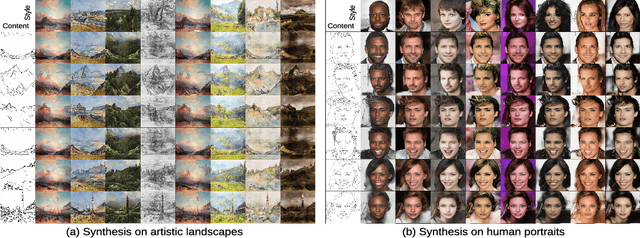
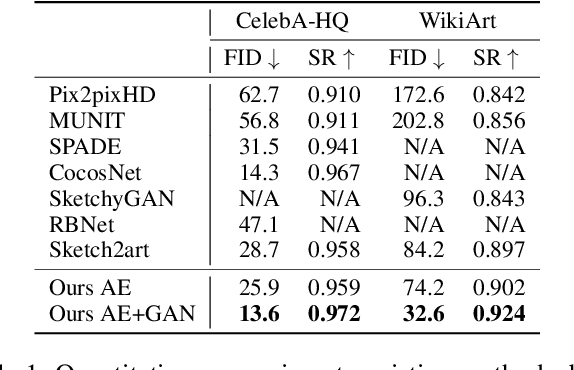
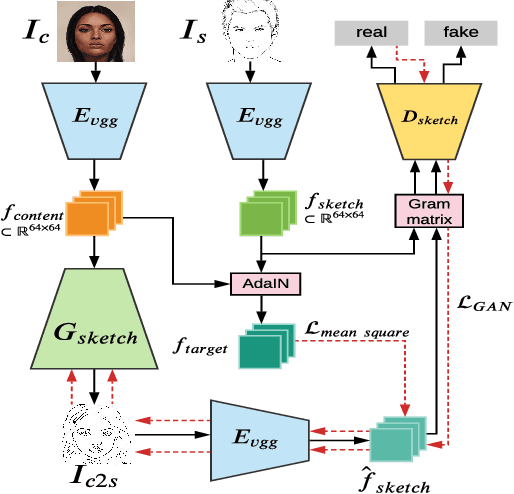
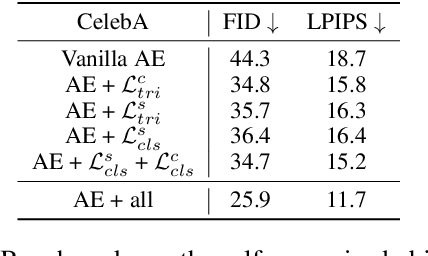
Abstract:Imagining a colored realistic image from an arbitrarily drawn sketch is one of the human capabilities that we eager machines to mimic. Unlike previous methods that either requires the sketch-image pairs or utilize low-quantity detected edges as sketches, we study the exemplar-based sketch-to-image (s2i) synthesis task in a self-supervised learning manner, eliminating the necessity of the paired sketch data. To this end, we first propose an unsupervised method to efficiently synthesize line-sketches for general RGB-only datasets. With the synthetic paired-data, we then present a self-supervised Auto-Encoder (AE) to decouple the content/style features from sketches and RGB-images, and synthesize images that are both content-faithful to the sketches and style-consistent to the RGB-images. While prior works employ either the cycle-consistence loss or dedicated attentional modules to enforce the content/style fidelity, we show AE's superior performance with pure self-supervisions. To further improve the synthesis quality in high resolution, we also leverage an adversarial network to refine the details of synthetic images. Extensive experiments on 1024*1024 resolution demonstrate a new state-of-art-art performance of the proposed model on CelebA-HQ and Wiki-Art datasets. Moreover, with the proposed sketch generator, the model shows a promising performance on style mixing and style transfer, which require synthesized images to be both style-consistent and semantically meaningful. Our code is available on https://github.com/odegeasslbc/Self-Supervised-Sketch-to-Image-Synthesis-PyTorch, and please visit https://create.playform.io/my-projects?mode=sketch for an online demo of our model.
Spatial Frequency Bias in Convolutional Generative Adversarial Networks
Oct 04, 2020



Abstract:As the success of Generative Adversarial Networks (GANs) on natural images quickly propels them into various real-life applications across different domains, it becomes more and more important to clearly understand their limitations. Specifically, understanding GANs' capability across the full spectrum of spatial frequencies, i.e. beyond the low-frequency dominant spectrum of natural images, is critical for assessing the reliability of GAN generated data in any detail-sensitive application (e.g. denoising, filling and super-resolution in medical and satellite images). In this paper, we show that the ability of GANs to learn a distribution is significantly affected by the spatial frequency of the underlying carrier signal, that is, GANs have a bias against learning high spatial frequencies. Crucially, we show that this bias is not merely a result of the scarcity of high frequencies in natural images, rather, it is a systemic bias hindering the learning of high frequencies regardless of their prominence in a dataset. Furthermore, we explain why large-scale GANs' ability to generate fine details on natural images does not exclude them from the adverse effects of this bias. Finally, we propose a method for manipulating this bias with minimal computational overhead. This method can be used to explicitly direct computational resources towards any specific spatial frequency of interest in a dataset, thus extending the flexibility of GANs.
TIME: Text and Image Mutual-Translation Adversarial Networks
May 27, 2020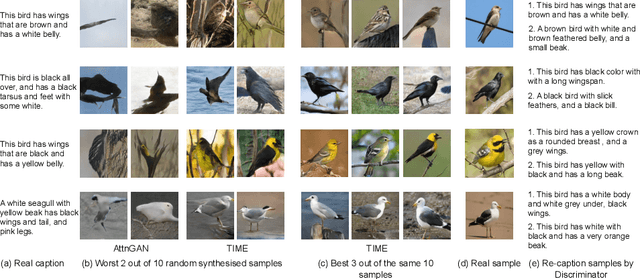

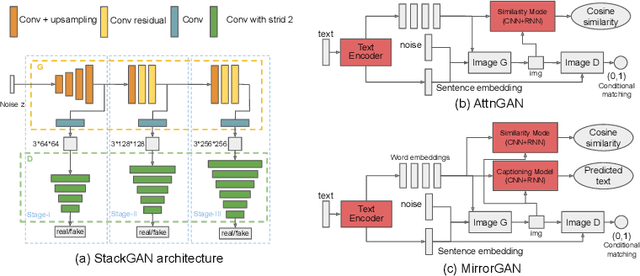

Abstract:Focusing on text-to-image (T2I) generation, we propose Text and Image Mutual-Translation Adversarial Networks (TIME), a lightweight but effective model that jointly learns a T2I generator $G$ and an image captioning discriminator $D$ under the Generative Adversarial Network framework. While previous methods tackle the T2I problem as a uni-directional task and use pre-trained language models to enforce the image-text consistency, TIME requires neither extra modules nor pre-training. We show that the performance of $G$ can be boosted substantially by training it jointly with $D$ as a language model. Specifically, we adopt Transformers to model the cross-modal connections between the image features and word embeddings, and design a hinged and annealing conditional loss that dynamically balances the adversarial learning. In our experiments, TIME establishes the new state-of-the-art Inception Score of 4.88 on the CUB dataset, and shows competitive performance on MS-COCO on both text-to-image and image captioning tasks.
Sketch-to-Art: Synthesizing Stylized Art Images From Sketches
Mar 03, 2020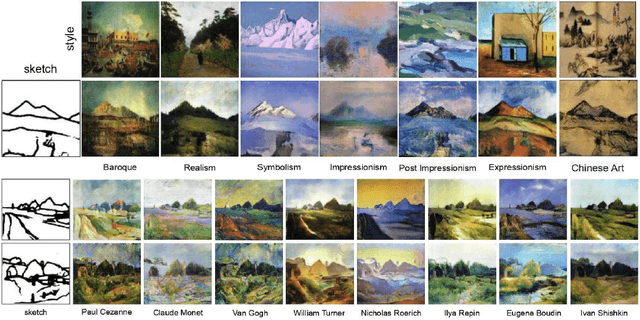

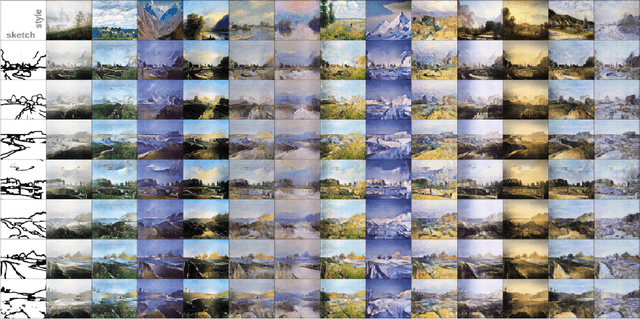

Abstract:We propose a new approach for synthesizing fully detailed art-stylized images from sketches. Given a sketch, with no semantic tagging, and a reference image of a specific style, the model can synthesize meaningful details with colors and textures. The model consists of three modules designed explicitly for better artistic style capturing and generation. Based on a GAN framework, a dual-masked mechanism is introduced to enforce the content constraints (from the sketch), and a feature-map transformation technique is developed to strengthen the style consistency (to the reference image). Finally, an inverse procedure of instance-normalization is proposed to disentangle the style and content information, therefore yields better synthesis performance. Experiments demonstrate a significant qualitative and quantitative boost over baselines based on previous state-of-the-art techniques, adopted for the proposed process.
 Add to Chrome
Add to Chrome Add to Firefox
Add to Firefox Add to Edge
Add to Edge